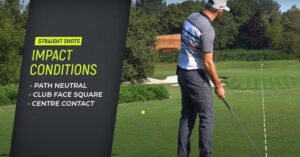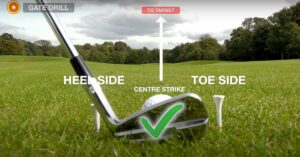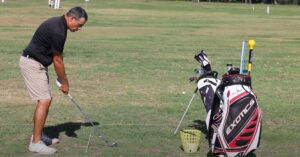How To Hit A Golf Ball For Beginners?
Golf, a sport known for its precision and technique, can be intimidating for beginners. If you’re new to the game and eager to learn how to hit a golf ball with confidence, you’ve come to the right place.
To hit a golf ball for beginners, start by setting up your stance with your feet shoulder-width apart and your weight evenly distributed. Then, grip the club with both hands and keep your arms straight as you swing back.
In this blog post, we will guide you through the essential steps to help you master the art of striking a golf ball.
How To Hit A Golf Ball: A Beginner’s Guide

Hitting a golf ball may seem intimidating at first, but with the right technique and practice, you can improve your skills. Here, we will cover the essential steps to help you hit a golf ball effectively and enjoy the game.
Step 1: Set Up Properly
Before taking a swing, ensure you have the correct stance. Stand with your feet shoulder-width apart, aligning them parallel to the target line. Keep your knees slightly flexed, maintain a straight back, and tilt forward from your hips.
Step 2: Grip the Club
Hold the golf club with a neutral grip. Position the club in your left hand (for right-handed golfers) with the clubface square to the target.
Wrap your fingers around the grip, placing your right hand below your left hand. Your hands should work together as a single unit.
Step 3: Align Your Body
Align your body parallel to the target line. Aim your clubface towards the target, ensuring it is square to the line.
Align your feet, hips, and shoulders parallel to the target line as well. This setup will help you hit the ball accurately.
Step 4: Take the Backswing
Initiate your backswing by turning your shoulders away from the target while keeping your lower body stable. Maintain a relaxed grip and allow your wrists to hinge naturally. Avoid excessive tension and keep your head still.
Step 5: Transition and Downswing
As you complete your backswing, start the transition to the downswing by shifting your weight onto your front foot. Begin your downswing by rotating your hips towards the target, followed by your upper body. This sequence generates power and clubhead speed.
Step 6: Impact and Follow-Through
As you approach impact, focus on striking the ball with the center of the clubface. Keep your eyes on the ball and maintain a smooth tempo.
After impact, continue your swing and follow-through with your arms extending towards the target. A balanced finish signifies a well-executed shot.
Step 7: Practice Consistently
Improving your golf swing takes practice and repetition. Dedicate time to practice regularly, focusing on each step of the swing. Consider taking lessons from a golf professional who can provide guidance and feedback tailored to your specific needs.
Golf Equipment Basics: Clubs, Balls, And Accessories

When it comes to golf, having the right equipment is essential for a successful game. From clubs to balls and accessories, each component plays a crucial role in your performance on the course.
Let’s delve into the basics of golf equipment to help you understand their importance and make informed choices.
Golf Clubs
Golf clubs are the primary tools used to strike the ball. A typical set consists of different types of clubs, including drivers, irons, wedges, and putters.
Drivers are used for long-distance shots, irons for versatility, wedges for short shots, and putters for precise putting on the greens.
Golf Balls
Golf balls come in a variety of designs and materials, each with its own characteristics. They are categorized based on compression, spin, and overall performance.
High-compression balls suit faster swing speeds, while low-compression balls are ideal for slower swings. Spin control balls help advanced players shape their shots.
Golf Accessories
In addition to clubs and balls, there are various accessories that can enhance your golfing experience. These include golf bags, gloves, tees, and ball markers. Golf bags are designed to carry and protect your clubs, while gloves provide grip and control.
Tees are used to elevate the ball before driving, and ball markers help you mark your ball’s position on the green.
Choosing the Right Equipment
Selecting the right golf equipment requires considering your skill level, swing speed, and personal preferences. It’s advisable to get fitted for clubs to ensure they are the right length, flex, and grip size for your body and swing.
Experimenting with different balls and accessories can help you find the ones that suit your game.
Common Swing Mistakes And How To Avoid Them
A well-executed swing is essential for a successful golf game, but it’s easy to fall into common mistakes. This article explores some common swing errors and offers tips to help you avoid them, improving your overall technique and performance on the course.
Grip and Stance
When it comes to the swing, a solid foundation is crucial. Many golfers struggle with their grip and stance, leading to inconsistent shots. Ensure your grip is firm but not overly tight, and position your feet shoulder-width apart with slight knee flexion.
Practice these fundamentals to establish a strong base for your swing.
Overactive Hands
One of the most prevalent mistakes is relying too much on hand action during the swing. This can lead to a lack of control and accuracy. Instead, focus on using your body as the driving force behind the swing, engaging your core and hips to generate power and maintain stability.
Poor Alignment
Alignment plays a significant role in the success of your swing. Make sure your body, clubface, and target line are properly aligned.
Use alignment rods or markers to assist you during practice and always double-check your alignment before each swing to maintain consistency and accuracy.
Lack of Tempo and Rhythm
Maintaining a consistent tempo and rhythm is vital for a smooth and controlled swing. Avoid rushing your backswing or downswing, as this can lead to a loss of balance and power. Practice swinging with a metronome or counting in your head to develop a consistent rhythm that suits your natural timing.
Swaying or Sliding
Another common mistake is excessive lateral movement during the swing, either swaying or sliding. This can result in inconsistent ball striking and a loss of power. Focus on maintaining your balance and keeping your weight centered throughout the swing, allowing for a more controlled and powerful strike.
Improper Weight Transfer
Proper weight transfer is essential for generating power and maintaining balance. Many golfers struggle with shifting their weight effectively from their back foot to their front foot.
Practice drills that emphasize weight transfer, such as the step-through drill or the reverse pivot drill, to improve this aspect of your swing.
Lack of Follow-through
A proper follow-through is often overlooked but is crucial for a complete and effective swing. Make sure to rotate your body fully and extend your arms toward the target after impact. A complete follow-through promotes a better transfer of energy and helps you maintain balance throughout the swing.
Frequently Asked Questions
If you’re new to golf and want to learn how to hit a golf ball, this guide will provide you with quick and clear answers to the most common questions beginners have.
Whether you’re stepping onto the course for the first time or looking to improve your swing, these tips will help you get started.
What’s The Correct Stance For Hitting A Golf Ball?
To hit a golf ball effectively, start with a shoulder-width stance, feet parallel to the target line. Keep your knees slightly flexed and maintain a straight back. Distribute your weight evenly on both feet and position the ball in line with your front heel.
How Do I Grip The Golf Club?
For a solid grip, hold the club with your left hand (for right-handed golfers) and interlock your right pinkie with your left index finger. Position your thumbs down the center of the grip.
This “Vardon grip” provides control and stability during your swing.
What’s The Proper Swing Technique?
Focus on a smooth, rhythmic swing rather than overpowering the ball. Start your backswing by rotating your shoulders and maintaining a straight left arm (right-handed golfers).
As you swing down, shift your weight to your front foot and aim to strike the ball with a square clubface.
How Can I Improve My Accuracy?
To improve accuracy, practice your alignment. Stand parallel to the target line, ensuring your clubface and body are aligned correctly. Use an alignment aid, such as a golf club or alignment stick, to guide you.
Additionally, focus on maintaining a consistent tempo and keeping your head still during the swing.
What Should I Do If I Slice The Ball?
If you consistently slice the ball, try adjusting your grip and stance. Strengthen your grip by rotating both hands slightly to the right (for right-handed golfers).
Also, check your alignment and ensure your body is not aiming left of the target. Practicing with a professional or taking lessons can further help you correct a slice.
Conclusion
Hitting a golf ball effectively requires proper technique, consistent practice, and the right equipment. By following the steps outlined in this beginner’s guide and avoiding common swing mistakes, you can improve your skills and enjoy the game of golf.
Remember to be patient, stay dedicated, and seek guidance when needed. Happy golfing!






